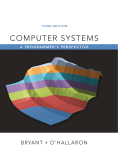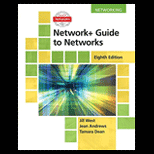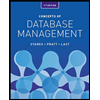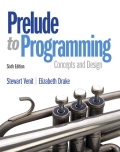
EBK COMPUTER SYSTEMS
3rd Edition
ISBN: 8220101459107
Author: O'HALLARON
Publisher: YUZU
expand_more
expand_more
format_list_bulleted
Question
Chapter 9, Problem 9.16HW
Program Plan Intro
Dynamic allocator:
Dynamic allocator keeps the heap as a group of several size blocks; each block is an attached portion of virtual memory which is allocated or free.
- An allocated block has been clearly kept for use by the application.
- A free block is offered to be allocated.
Two types of allocators:
- 1. Explicit allocators
- 2. Implicit allocators
Explicit allocators:
Explicit allocators need the application to explicitly free any allocated blocks.
Implicit allocators:
Implicit allocators is the method of automatically releasing vacant allocated blocks. This is also known as garbage collection.
Explicit free list:
In this method, a block contains one word header, payload and additional padding. The header encrypts the block size which contains header and padding; and also check the block is allocated or free.
- The heap can be organized doubly linked list by including predecessor and successor pointer in each free block.
- This method reduces the allocation time when compared to implicit free list.
- If the arrangement is single-word, the block size is constantly a multiple of “4” and the low-order bits of the block size are always zero.
- If the arrangement is double-word, the block size is constantly a multiple of “8” and the low-order bits of the block size are always zero.
Expert Solution & Answer
Want to see the full answer?
Check out a sample textbook solution
Students have asked these similar questions
From the following mass-spring system, obtain its transfer function and pole-zero
diagram in MATLAB. Analyze how stability varies when entering values.
wwwww
R
-0000
e(t)
i(t)
e(t) is the input variable, and the voltage across the capacitor is the controlled
variable.
Conduct a comprehensive study on Botnet networks, focusing on their architecture and functionality. Provide a detailed analysis of their control mechanisms via C2 (Command and Control) structures, and classify the different types of Botnets (centralized, decentralized, hybrid). Explain their primary uses in offensive contexts and discuss the evolution of detection and mitigation techniques in light of technological advancements in cybersecurity.
Additional Note:
Design a complete Botnet simulator using Python programming, including both the C2 server and the bot client. Demonstrate how the bots connect to the server, and how commands are sent and received between them.
I want to explain my
work in Python
botnets and it is
completely working
on the tkinter function
with an explanation
of how I can work on
it with an introduction
about what it is and
what its benefit is
Chapter 9 Solutions
EBK COMPUTER SYSTEMS
Ch. 9.2 - Prob. 9.1PPCh. 9.3 - Prob. 9.2PPCh. 9.6 - Prob. 9.3PPCh. 9.6 - Prob. 9.4PPCh. 9.8 - Practice Problem 9.5 (solution page 882) Write a C...Ch. 9.9 - Prob. 9.6PPCh. 9.9 - Prob. 9.7PPCh. 9.9 - Prob. 9.8PPCh. 9.9 - Prob. 9.9PPCh. 9.9 - Prob. 9.10PP
Ch. 9 - Prob. 9.11HWCh. 9 - Repeat Problem 9.11 for the following address....Ch. 9 - Repeat Problem 9.11 for the following address....Ch. 9 - Given an input file hello.txt that consists of the...Ch. 9 - Determine the block sizes and header values that...Ch. 9 - Prob. 9.16HWCh. 9 - Prob. 9.17HWCh. 9 - Prob. 9.18HWCh. 9 - Prob. 9.19HWCh. 9 - Write your own version of malloc and free, and...
Knowledge Booster
Similar questions
- When you connect your device to Wi-Fi, what happens "under the hood"? Explain in detail, with pictures, what it's like.arrow_forwardYou will write a program that allows the user to keep track of college locations and details about each location. To begin you will create a College python class that keeps track of the csollege's unique id number, name, address, phone number, maximum students, and average tuition cost. Once you have built the College class, you will write a program that stores College objects in a dictionary while using the College's unique id number as the key. The program should display a menu in this order that lets the user: 1) Add a new College 2) Look up a College 4) Delete an existing College 5) Change an existing College's name, address, phone number, maximum guests, and average tuition cost. 6) Exit the programarrow_forwardI need help with this problem and an step by step explanation of the solution from the image described below. (Introduction to Signals and Systems)arrow_forward
- I need help with this problem and an step by step explanation of the solution from the image described below. (Introduction to Signals and Systems)arrow_forwardI need help with this problem and an step by step explanation of the solution from the image described below. (Introduction to Signals and Systems)arrow_forwardI need help with this problem and an step by step explanation of the solution from the image described below. (Introduction to Signals and Systems)arrow_forward
- Hello, Please read the provided text carefully—everything is detailed there. I need high-quality diagrams for both cases: Student A and Student B, showing the teacher teaching them through knowledge distillation. Each case should be represented as a separate image. The knowledge distillation process must be clearly illustrated in both. I’ve attached an image that shows the level of clarity I’m aiming for. Please do not use AI-generated diagrams. If I wanted that, I could do it myself using ChatGPT Premium. I’m looking for support from a real human expert—and I know you can help. " 1. Teacher Model Architecture (T) Dataset C: Clean data with complete inputs and labels Architecture Input Embedding Layer Converts multivariate sensor inputs into dense vectors. Positional Encoding Adds time-step order information to each embedding. Transformer Encoder Stack (repeated N times) Multi-Head Self-Attention: Captures temporal dependencies across time steps. Add…arrow_forward(connection)? Q1: Define the BGP ? Ebgp vs I bgp, and how do I advertise? With a drawing example QT: Explain how to make messages in the BGP protocol. Q: What is concept the hot potato routing in BGP? Q: What are the criteria for BGP route selection? Qo: Define the concept of Spanning Tree Protocol. Explain in detail and draw the figures. Q1: What happens when STP is disabled? QV: Define the concept of broadcast storm. QA: List and explain the Steps to a Loop-Free Topology when using the Spanning Tree Algorithm and Spanning Tree Protocol in a four-step process. I want a typical and concise Solutionarrow_forwardWATCH THE VIDEO ABOUT MODELLING OR SPECIFICATION PHASE AND ANSWER THE FOLLOWING QUESTIONS: https://www.youtube.com/watch?v=uoIxDeAyfdo 1.- DEFINE SPECIFICATION OR MODELLING 2.- WRITE DOWN THE 3 REQUIREMENTS SPECIFICATION TECHNIQUES OR FORMATS 3.-DEFINE USE CASES 4.-DEFINE SRS 5.-DEFINE USER STORIES 6.- IS IT RECOMMENDABLE TO USE SRS DOCUMENTS IN AGILE METHODOLOGY? WHY? 7.- HOW DO YOU KNOW WHICH TECHNIQUE OR FORMAT TO USE? 8.- WRITE DOWN THE USE CASE COMPONENTSarrow_forward
- READING AND LISTENING ACTIVITIES BASED ON THE VIDEO: “REQUIREMENT ELICITATION “ Watch the following video and look for the answer to the following questions: https://www.youtube.com/watch?v=pSQRetBoaRE&t=24s 1.-NAME THE 2 PHASES OF THE REQUIREMENT ENGINEERING PROCESS 2.-NAME AT LEAST 7 ELICITATION TECHNIQUES TO COLLECT THE INFORMATION REQUIRED 3.-REFER TO THE NUMBER OF QUESTIONS AND TYPE OF QUESTIONS THAT SHOULD BE ASKED TO THE DIFFERENT STAKEHOLDERS. 4.-NAME THE DIFFERENT TYPES OF PROBLEMS YOU CAN ENCOUNTER DURING THE REQUIREMENT ELICITATION PROCESS 5.- ACCORDING TO THE VIDEO, WHICH TYPES OF TECHNIQUES SHOULD YOU USE, WHICH ONES WOULD YOU USE ACCORDING TO PROFESSOR SHERRIFF ‘S RECOMMENDATIONS?arrow_forwardCan you please show me how I can do this on google sheets. For the spreadsheet you need to create a multi page sheets thing that uses all the techniques of counts/sums and graph showing how many contracts have been returned for each grade...you can make up the data (let's say in grade 9 I got 15 contracted back with fake data that I want you to show me how to create on google spreadsheet) For grade 10 i got 20 contracts signed, for grade 11 I got 16 contracts and for grade 12 I got 25 contracts back. Can you help me pls. Thanks so much. Make sure you have graphs on the page and also the sum written as a formula and the numbers filled in the columns.arrow_forwardI need help with this problem and an step by step explanation of the solution from the image described below. (Introduction to Signals and Systems)arrow_forward
arrow_back_ios
SEE MORE QUESTIONS
arrow_forward_ios
Recommended textbooks for you
 Computer Networking: A Top-Down Approach (7th Edi...Computer EngineeringISBN:9780133594140Author:James Kurose, Keith RossPublisher:PEARSON
Computer Networking: A Top-Down Approach (7th Edi...Computer EngineeringISBN:9780133594140Author:James Kurose, Keith RossPublisher:PEARSON Computer Organization and Design MIPS Edition, Fi...Computer EngineeringISBN:9780124077263Author:David A. Patterson, John L. HennessyPublisher:Elsevier Science
Computer Organization and Design MIPS Edition, Fi...Computer EngineeringISBN:9780124077263Author:David A. Patterson, John L. HennessyPublisher:Elsevier Science Network+ Guide to Networks (MindTap Course List)Computer EngineeringISBN:9781337569330Author:Jill West, Tamara Dean, Jean AndrewsPublisher:Cengage Learning
Network+ Guide to Networks (MindTap Course List)Computer EngineeringISBN:9781337569330Author:Jill West, Tamara Dean, Jean AndrewsPublisher:Cengage Learning Concepts of Database ManagementComputer EngineeringISBN:9781337093422Author:Joy L. Starks, Philip J. Pratt, Mary Z. LastPublisher:Cengage Learning
Concepts of Database ManagementComputer EngineeringISBN:9781337093422Author:Joy L. Starks, Philip J. Pratt, Mary Z. LastPublisher:Cengage Learning Prelude to ProgrammingComputer EngineeringISBN:9780133750423Author:VENIT, StewartPublisher:Pearson Education
Prelude to ProgrammingComputer EngineeringISBN:9780133750423Author:VENIT, StewartPublisher:Pearson Education Sc Business Data Communications and Networking, T...Computer EngineeringISBN:9781119368830Author:FITZGERALDPublisher:WILEY
Sc Business Data Communications and Networking, T...Computer EngineeringISBN:9781119368830Author:FITZGERALDPublisher:WILEY

Computer Networking: A Top-Down Approach (7th Edi...
Computer Engineering
ISBN:9780133594140
Author:James Kurose, Keith Ross
Publisher:PEARSON

Computer Organization and Design MIPS Edition, Fi...
Computer Engineering
ISBN:9780124077263
Author:David A. Patterson, John L. Hennessy
Publisher:Elsevier Science

Network+ Guide to Networks (MindTap Course List)
Computer Engineering
ISBN:9781337569330
Author:Jill West, Tamara Dean, Jean Andrews
Publisher:Cengage Learning

Concepts of Database Management
Computer Engineering
ISBN:9781337093422
Author:Joy L. Starks, Philip J. Pratt, Mary Z. Last
Publisher:Cengage Learning

Prelude to Programming
Computer Engineering
ISBN:9780133750423
Author:VENIT, Stewart
Publisher:Pearson Education

Sc Business Data Communications and Networking, T...
Computer Engineering
ISBN:9781119368830
Author:FITZGERALD
Publisher:WILEY